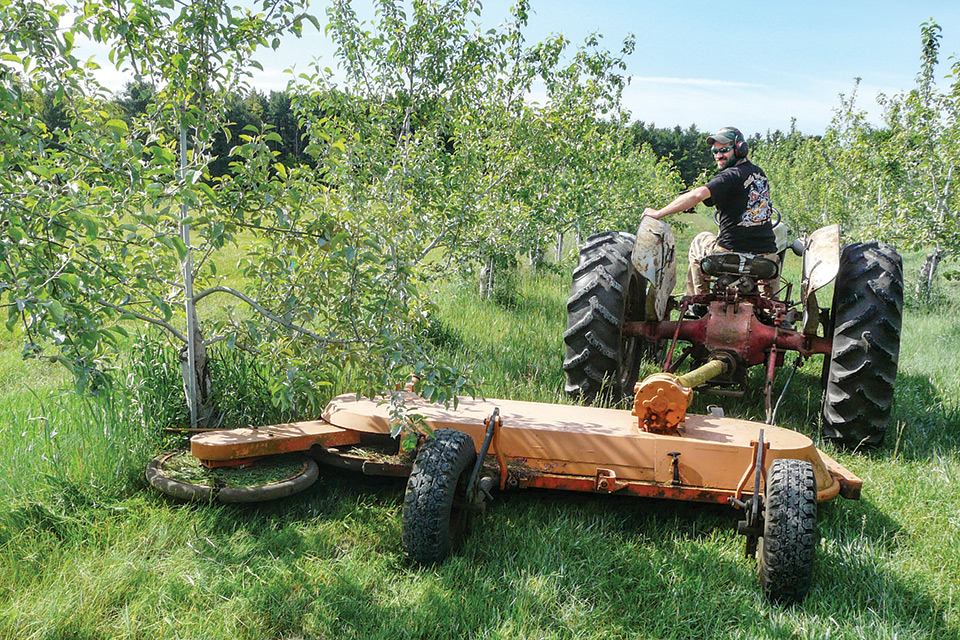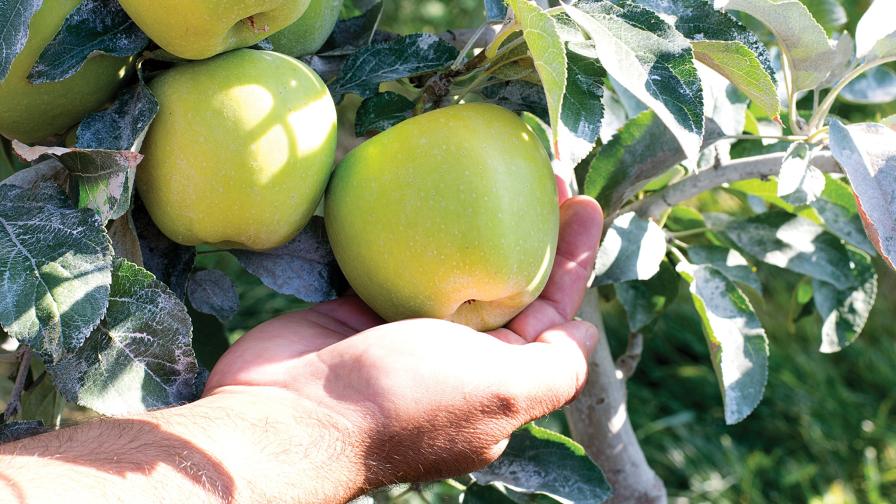Best Practices for Non-Chemical Orchard Weed Management

Mowing semi-dwarf trees with a swing-arm mower. (Photo: Terence Bradshaw)
Editor’s note This bulletin is part of an educational series from the University of Vermont’s Apple Program. The full article can be found online.
Groundcover management in apple orchards is a critical component of successful fruit production. Apple trees require weed-free competition for at least part of the year and especially during the initial establishment years in order to maximize vegetative growth and fruit production. However, maintenance of a complete vegetation-free zone underneath and between trees in an orchard is not desirable, as it would lead to soil erosion and other declines in soil health and quality.
The ‘Weed-Free Strip’
Apples have relatively deep roots compared to many weed species. However, changes in orchard architecture to favor dwarf rootstocks with shallow root systems make those trees less competitive with weeds than trees on semi-dwarfing or larger rootstocks. For those larger, established trees, a sod groundcover mowed with an offset mower may be acceptable, but grasses and other covers growing under the trees may compete for water and nutrients and reduce crop yield and/or tree growth. Even deep-rooted semi-dwarf trees will benefit from reduced weed competition during orchard establishment.
It is not necessary or preferable to maintain a vegetation-free strip under apple trees all season, and doing so may lead to a decline in soil health over time. Research has shown that the critical weed-free period is from bloom through about mid-July, when tree growth and nutrient needs are greatest. That does not mean that weeds should be allowed to grow unmanaged late in the season. Groundcovers that grow up into the tree canopy can increase fungal disease, and tree trunks that are obscured by dense-growing vegetation have greater risk for borer and vole problems than exposed trunks.
Goals for under-tree vegetation maintenance should include: excellent weed control from pre-bloom through July; maintenance or increase of soil organic matter levels (optimum is 3% to 6%); control of perennial, especially woody, weed species; and maintenance of under-tree groundcovers to maximize trunk exposure and reduce vole habitat.
Mowing
The orchard-row middles require mowing several times per year to provide access through the planting for workers and equipment, to reduce vole habitat, and to reduce moisture in tree canopies. Mowers with a spring- or hydraulic-activated arm may be used to mow vegetation under trees and even up close to the tree trunks. Mowed sod systems are only recommended for vigorous trees and in non-droughty soils. In some cases, ‘brushing out’ trees with weed whackers or machetes is necessary to control vegetation close to tree trunks or in the narrow band between trees.
Herbicides
Herbicides are commonly used to maintain a weed-free strip in orchard tree rows, but an integration of chemical and non-chemical approaches may improve overall groundcover management. For example, both systemic and contact herbicides are effective tools for ‘killing back’ under-tree covers in late fall or spring, or for managing woody and/or perennial weed species that may become established when using non-chemical methods. There are several organic-certified herbicide products that, in our experience, are ineffective for this rescue or cleanup application and rather must be used only on young weeds that can be managed with other methods more cost-effectively. There is danger of damaging trees with herbicides, especially when young and bark is easily penetrated by spray material. If using herbicides near young trees, careful and exact application methods should be used to minimize contact with bark and foliage.
Cultivation
Used properly, cultivation can be an important tool for managing weeds and incorporating soil organic matter. However, excessive or overly aggressive cultivation can damage trees and reduce soil quality. Ideally, cultivation will only disturb the top 1 or 2 inches of soil. If used as the primary weed management practice, it often must be performed four to six times per season to prevent weeds from becoming too large. Repeated cultivation may decrease soil organic matter and reduce overall soil quality.
Tractor-mounted under-tree cultivators come in many makes and models. Cultivators with hydraulically powered rotating tines may be useful for many orchard practices, including hilling up soil, removing berms in the tree middles, breaking up established sod, and general cultivation. However, their aggressive nature requires very careful operator attention and slow ground speeds, which may limit their use in large plantings.
Another type of tractor-mounted cultivator uses ground-driven ‘spider’ wheels that are less aggressive than rotary tines but are also less effective against heavy sod and may not be used to move or level soil under trees for berm management. These cultivators may be operated at relatively high speeds (5 to 7 mph) and can cover a lot of ground quickly.
Mulching
Mulches can provide very good weed control, but their benefits come with certain drawbacks. Groundcovers like plastic mulch and landscape cloth provide habitat for voles and prevent nutrient and sometimes water assimilation into the soil and are not recommended for use in orchards. Leaves and straw can successfully control weeds but may be difficult or costly to source in large quantities and also provide excellent vole habitat.
Wood chips applied 4 to 6 inches deep are the best organic mulch and can often be sourced from municipal tree companies for relatively low cost or even for free. Ideally, they would be applied to a clean, weed-free surface so herbicide application or cultivation prior to applying wood chips is recommended. There is some concern that wood chips applied to the soil will tie up nitrogen, but that is debatable, and likely would only happen at the soil-mulch interface and not deeper in the soil profile where most tree roots are. Tractor-pulled, side-discharge mulch spreaders can greatly speed application time and efficiency.
Because wood mulches are composed of the similar tissues as apple trees, they often contain nutrients in roughly the quantities required in orchards. As chips break down, they will increase soil organic matter content and overall nutrient levels. Cultivation of fresh chips into the soil is not recommended, but decomposed wood chips may be tilled into the soil prior to the next application, which can speed their decomposition and release nutrients.
Putting it All Together
Ideally, a combination of practices will be used to manage under-tree groundcovers for optimum weed control, soil health, and tree fertility. Generally, flame weeding is not particularly effective in most orchard systems. During the first and second years from establishment, a clean strip around trees should be maintained to reduce weed competition. As trees reach third leaf and later, some tolerance for weed competition beginning in midsummer may be acceptable. Mulches applied during this time will provide 1 to 2 years of control, then may be cultivated into the soil and reapplied as necessary. As soil organic matter increases, it may be helpful to take a year off from mulching and use cultivation to reduce soil berms and break up any vole habitat that has formed and knock back established weeds. If herbicides are a consideration, they may be used judiciously during this program to clean up weed issues, especially for woody or perennial species.
| Method | Relative Cost | Effectiveness | Advantages | Disadvantages |
|---|---|---|---|---|
| Hand Weeding | High | Moderate | Precision, avoids damage to trees. | High labor cost, back-breaking. |
| Mowing | Low to Medium | Moderate | Low cost (mowing row middles anyway). | Not effective for dwarf or new plantings. |
| Herbicide | Low | High | Precise, adaptable to specific weed issues. | Not organic; potential tree damage; may reduce soil quality; knowledge-intensive. |
| Flame Weeding | Medium to High | Low | Quick burndown. | No residual effect; tree damage; fire hazard. |
| Cover Crops | Medium | ? | Build soil organic matter, outcompete weeds. | May be as competitive as weeds; difficult to manage. |
| Cultivation | Medium | High | Very good weed control if performed correctly. | Decline in soil health; equipment selection, tree damage. |
| Mulching | High | Medium-high | Improved soil health, organic matter. | Vole habitat); need for reapplication; mulch cost; short residual for cost. |










